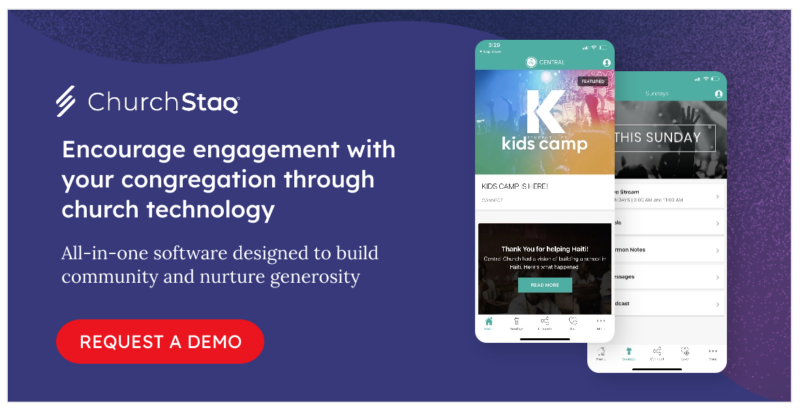
10 Simple Church Communication Best Practices
Good communication is a vital part of a healthy church. To maximize your message's impact, we’ve pulled together 10 best practices for church communication.
Good communication is a vital part of a healthy church. The more informed your congregation is, the more they will participate in your ministries, programs, events, and growth opportunities. And if you effectively communicate with your larger community, more people outside your church will understand who you are and visit your services.
To help you maximize the impact of your message, we’ve pulled together 10 best practices for church communication.
1. Focus on the best communication channels
If your church members don’t use Twitter, you probably shouldn’t, either. Your staff is already stretched thin—why ask them to spend time on a channel that isn’t going to reach the right people?
Many churches attempt to be on every social media platform, and they use more communication channels than they can keep up with. But if you want to be as effective as possible and use your time wisely, you need to focus on the platforms and channels your congregation (or the community you want to reach) actually uses.
But you also need to drive them toward the channels that work best for you. Everyone is on Facebook, but that’s probably not the best way for your church to communicate what’s going on. A dedicated church app, on the other hand, is the perfect way to share updates with your congregation—but no one will use it unless you drive them there.
Rather than just going wherever your congregation is, your church should be decisive about what tools you use. Choose the communication platform you can be most effective with, and get your congregation to use it.
2. Use your app to support what you say in person
When you see your congregation every week, it’s easy to assume they’ve already heard your announcements and that they know what’s going on in your church. Some churches wind up with a pretty big disconnect between the information they communicate in person during the service and the information that’s available on their church app.
Your church app should emphasize the same things you talk about during your service, whether that’s an event, ministry, or anything else you want your congregation to know about or get involved in.
3. Re-engage church members and visitors with ads
Ads are a great tool to drive people to specific pages of your website. You can target your Facebook ads to people who have filled out communication cards and given you their email, or people who have visited your website recently. You could even make your ads specific to people who recently visited your livestream.
If you only communicate via email or social media, you’re going to miss opportunities to engage people who are connected to your church. Advertising can help you reach people who otherwise slip through the cracks of your mass communications.
4. Listen to your audience
Whether it happens from the pulpit, via email, through direct mail, or on social media, mass communication often goes one way. You say something, and your congregation listens. But if you want to communicate effectively, you need to create opportunities to listen to your congregation as well. What are their desires for your church, your community, and their role within it? What has their experience been like with your ministries and programs? How do they want to grow?
You can create in-person opportunities for people to share, but you’ll hear from more people if it’s convenient for them to share their thoughts. With Pushpay, you can use Attitude Polls to get feedback from anyone who has your church app. You can ask anything you want, and you can frame how you’d like church members to respond or just let them fill-in-the-blank.
5. Know your audience
You shouldn’t talk to a newcomer the same way you talk to someone who’s been coming to your church for years. They don’t have the context they need to understand nuances about your church, and they aren’t as invested in who you are and what you do yet. With email, you should always create a separate series of emails to nurture church visitors and help them get acquainted with your church before including them on your regular email updates.
6. Communicate in a variety of ways
While you’ve probably heard or embraced some version of “we all learn in different ways,” or “I’m a visual learner,” modern psychologists are pretty adamant that this isn’t true. You don’t have to communicate in different ways to accommodate different “learning styles.” But using visuals and giving people opportunities to interact with your message can reinforce what you’re trying to communicate. Keeping your communications interesting and engaging helps ensure your congregation will look forward to hearing what you have to say—and hopefully retain more of what they hear.
7. Personalize your messages
People like to know they’re not just a number to you. Your communication should always feel personal and relevant to the people you’re talking to. Ideally, even mass emails should use people’s first names, and they should come from a specific person in leadership they can reply to.
8. Repeat important information frequently
When you make a big announcement from the pulpit or in a newsletter, it’s easy to assume everyone knows everything about it. You communicated the details. You gave them the information. You showed them how to take the next step. But if you want people to show up for your event, get involved in your ministry, download your church app, or switch to recurring giving, you need to repeat key information often.
9. Leverage the strengths of each channel
Instagram is a great platform for visually showcasing what’s happening at your church. But it’s not very useful for driving traffic to your website or explaining things in depth. Email is good for transactional communications and long-form messaging, but you can’t link to emails from other channels, and they’re not as convenient for using visuals. Whatever communication channels and social platforms your church uses, be sure you’re playing to its strengths and not trying to shoehorn your message into a medium that isn’t suited for it.
10. Make sure there’s always a way to learn more
Not every announcement, email, or post has to say everything there is to know about your topic. But there should always be a clear path for people to learn more about what you’re talking about—whether that’s in your app, on your website, in a video, or at a physical location on your campus.
Avoid church communication blunders
Many churches struggle to use email effectively. And every poorly-performing email represents a missed opportunity to reach more people, recruit volunteers, raise funds for a new campaign, or just to remind people to sign up their kids for childcare before a Bible study session.
In our free ebook, The Seven Deadly Sends of Church Email Marketing, we’ll show you what a thriving, healthy email list looks like.
Download your free copy of The Seven Deadly Sends of Church Email Marketing.






